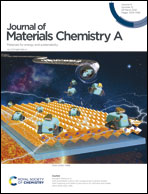Deep levels in cesium lead bromide from native defects and hydrogen†
Abstract
Lead halide perovskites such as CsPbBr3 have achieved widespread attention as optoelectronic materials, due in large part to their good performance despite significant defect densities. This “defect tolerance” has often been explained by hypothesizing that there is negligible trap-assisted non-radiative recombination in these materials because none of the dominant defects give rise to deep levels in the gap. We refer to this as the “shallow defect hypothesis”. In this work, we reject the shallow defect hypothesis for CsPbBr3. Via a thorough first-principles inventory of native defects and hydrogen impurities, we show that a number of relevant defects do in fact have deep levels, most notably the bromine interstitial and hydrogen interstitial. This adds to a growing body of evidence against the shallow defect hypothesis, suggesting that the observed defect tolerance may be due instead to relatively low recombination rates at deep levels. Guided by the theoretical identification of these defects, experiments can take steps to mitigate trap-assisted non-radiative recombination, further boosting the efficiency of lead halide perovskite optoelectronics.



 Please wait while we load your content...
Please wait while we load your content...